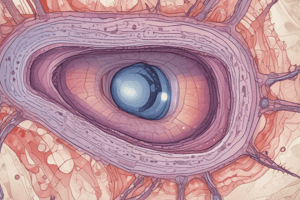Podcast
Questions and Answers
What is the classification of stratified epithelial tissue based on?
What is the classification of stratified epithelial tissue based on?
- Presence of keratin
- Number of layers of cells (correct)
- Types of cells in the basal layer
- Function within the body
Which type of stratified epithelium contains nonnucleated dead cells in its superficial layer?
Which type of stratified epithelium contains nonnucleated dead cells in its superficial layer?
- Stratified columnar epithelium
- Keratinized stratified squamous epithelium (correct)
- Stratified squamous non-keratinized type
- Stratified cuboidal epithelium
Where can non-keratinized stratified squamous epithelium be found in the body?
Where can non-keratinized stratified squamous epithelium be found in the body?
- Ducts of sweat glands
- Vocal folds
- Oral cavity (correct)
- Skin
Which region of the body is lined by stratified columnar epithelium?
Which region of the body is lined by stratified columnar epithelium?
What is the cell shape of the superficial layer in stratified cuboidal epithelium?
What is the cell shape of the superficial layer in stratified cuboidal epithelium?
Which type of stratified squamous epithelium protects underlying structures and acts as a barrier against pathogens?
Which type of stratified squamous epithelium protects underlying structures and acts as a barrier against pathogens?
What distinguishes keratinized stratified squamous epithelium from non-keratinized?
What distinguishes keratinized stratified squamous epithelium from non-keratinized?
Which type of stratified squamous epithelium lines the moist cavities of the mouth?
Which type of stratified squamous epithelium lines the moist cavities of the mouth?
Where can one find stratified columnar epithelium within the body?
Where can one find stratified columnar epithelium within the body?
What shape are the superficial cells in stratified cuboidal epithelium?
What shape are the superficial cells in stratified cuboidal epithelium?
Flashcards are hidden until you start studying
Study Notes
Transitional Epithelium
- Lines the major part of the urinary passage, also known as Urothelium
- Cell thickness depends on stretching; in a full bladder, it appears 2-3 layers thick, and in an empty bladder, 5-6 layers thick
- Cells become flattened on stretching due to distension of the bladder
- On relaxation in an empty bladder, cells become cuboidal or polygonal
- Basal cells are cuboidal and rest on basal lamina
- Cells of the upper layer are polygonal
- Cells of the most superficial layer are dome-shaped/umbrella-shaped and more eosinophilic due to the presence of plaque
- Plaque consists of intramembranous glycoproteins
- Surface cells may show mitotic activity (two nuclei in a single cell)
- Found in the renal calyces, renal pelvis, ureter, urinary bladder, and part of the urethra
Stratified Epithelium
- Classified into four types based on the shape of the superficial layer: squamous, cuboidal, columnar, and stratified columnar
- Stratified squamous epithelium: composed of many layers of cells
- Basal layer composed of columnar or cuboidal cells
- Middle cell layers composed of polygonal cells
- Superficial layer composed of squamous cells
- Two types of stratified squamous epithelium: keratinized and non-keratinized
- Keratinized stratified squamous epithelium: found in skin
- Non-keratinized stratified squamous epithelium: found in the oral cavity, esophagus, vagina, and anal canal
- Functions: protects underlying structures and acts as a barrier against pathogenic organisms
Stratified Columnar Epithelium
- Found in the epithelial lining of some ducts of salivary glands, fornix of conjunctiva, and cavernous urethra
- Superficial layer composed of columnar cells
- Basal cells are cuboidal and rest on basal lamina
Studying That Suits You
Use AI to generate personalized quizzes and flashcards to suit your learning preferences.




